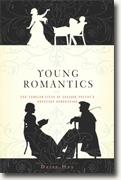Young Romantics
Daisy Hay
book reviews:
· general fiction
· chick lit/romance
· sci-fi/fantasy
· graphic novels
· nonfiction
· audio books
· author interviews
· children's books @
curledupkids.com
· DVD reviews @
curledupdvd.com
newsletter
win books
buy online
links
home
for authors
& publishers
for reviewers

 |
Young Romantics: The Tangled Lives of English Poetry's Greatest Generation Daisy Hay Farrar, Straus & Giroux Hardcover 384 pages April 2010 |
|
Young Romantics
Hay’s thesis is not completely convincing, and she sometimes strains too hard to prove it. Still, she has produced an engaging group biography about a generation of fascinating men and women while supplying a useful corrective to the traditional view of their lives. Leigh Hunt has faded into semi-obscurity because his journalistic work was by its nature ephemeral. But his relationship with Percy Bysse Shelley forms the fulcrum on which this book turns. Byron was an early supporter of Leigh Hunt and later a failed business partner. He and Shelley were linked by their lovers and came together from time to time in Switzerland and Italy. Keats had a only a tenuous connection to their group. He was briefly in Leigh Hunt’s circle but soon broke away in order to find his own voice. Hunt was a terrible manager of money and, like all the characters in this book, led a mixed-up personal life. While devoted to his wife, Marianne, he also seems to have carried a torch for her sister, Bess, apparently unconsummated. Shelley himself was married to the rather dull Harriet, by whom he had two children, when he met the brilliant, beautiful, intellectual Mary Godwin, then 16, with whom he eloped. Two years later, the 21-year-old Harriet committed suicide by drowning herself. This is the just first of an amazing catalogue of untimely death and personal tragedy this book encompasses. One of Mary’s half-sisters, Fanny, also committed suicide, while Bess also tried to drown herself but failed. Keats of course died of tuberculosis aged 26; Shelley drowned in a sailing accident aged 29; Byron made it to the age of 36 and died of disease and medical malpractice in Greece. Mary Shelley had a second half-sister – Claire Clairmont. Possibly jealous of Mary’s success in hooking a poet, she decided to find her one of her own and wrote an extraordinary letter to Lord Byron, a complete stranger, throwing herself at him. The result was a brief affair and a daughter, Allegra. Bryon soon tired of Claire and refused to see her. However, under the law of the day which gave no rights to mothers (or to women in general) he exercised his right to rip Allegra away from her loving mother. He soon found he didn’t want the infant around either, though he refused to allow Claire any access to her and shoved her out of sight into a convent, where she died at the age of five of typhoid or malaria. Claire continued to hang around with the Shelleys. She may have had an affair with the poet, and there is the suggestion she bore him a child – which soon died. Mary Shelley herself went from one pregnancy to the next. Four of her five children died young. With all this tragedy, how did she have the time and strength to write Frankenstein? Daisy Hay has a little scoop in this book which she saves for the final pages: a previously unknown autobiographical fragment written by Claire in which she describes both Shelley and Byron as “monsters of lying, meanness, cruelty and tragedy.” After reading this book, one feels that verdict is about right. This book concerns a time when poetry really mattered, when new poems excited heated public debate and poets were public figures of the first order. When Byron published the first two cantos of “Childe Harold,” he woke up to find himself famous. His poem “The Corsair” sold 10,000 copies on the first day of publication. But today, who outside of English lit majors reads this stuff? The author could have done much more to explain the greatness of some of the poetry and why it still matters today - if indeed it does. Originally published on Curled Up With A Good Book at www.curledup.com. © Alan Elsner, 2010 |
|
|
|
 Click here to learn more about this month's sponsor! |
|
| fiction · sf/f · comic books · nonfiction · audio newsletter · free book contest · buy books online review index · links · · authors & publishers reviewers |
|
| site by ELBO Computing Resources, Inc. | |
 On the contrary, insists Daisy Hay. This generation of romantic poets viewed poetry as a powerful political weapon. They lived at a time of government repression against free speech and civil rights following the end of the Napoleonic Wars. Far from working in isolation, they sharpened their intellects and forged their artistic identities through friendship, conversation and sociability. “They talked to each other, fought with each other, hated each other and fell in love. Their stories demonstrate that friendship is not always easy; that relationships with other people can simultaneously be a source of great strength and unknowable pain. But they also show that friendship can be the making of the main,” Hay writes.
On the contrary, insists Daisy Hay. This generation of romantic poets viewed poetry as a powerful political weapon. They lived at a time of government repression against free speech and civil rights following the end of the Napoleonic Wars. Far from working in isolation, they sharpened their intellects and forged their artistic identities through friendship, conversation and sociability. “They talked to each other, fought with each other, hated each other and fell in love. Their stories demonstrate that friendship is not always easy; that relationships with other people can simultaneously be a source of great strength and unknowable pain. But they also show that friendship can be the making of the main,” Hay writes.